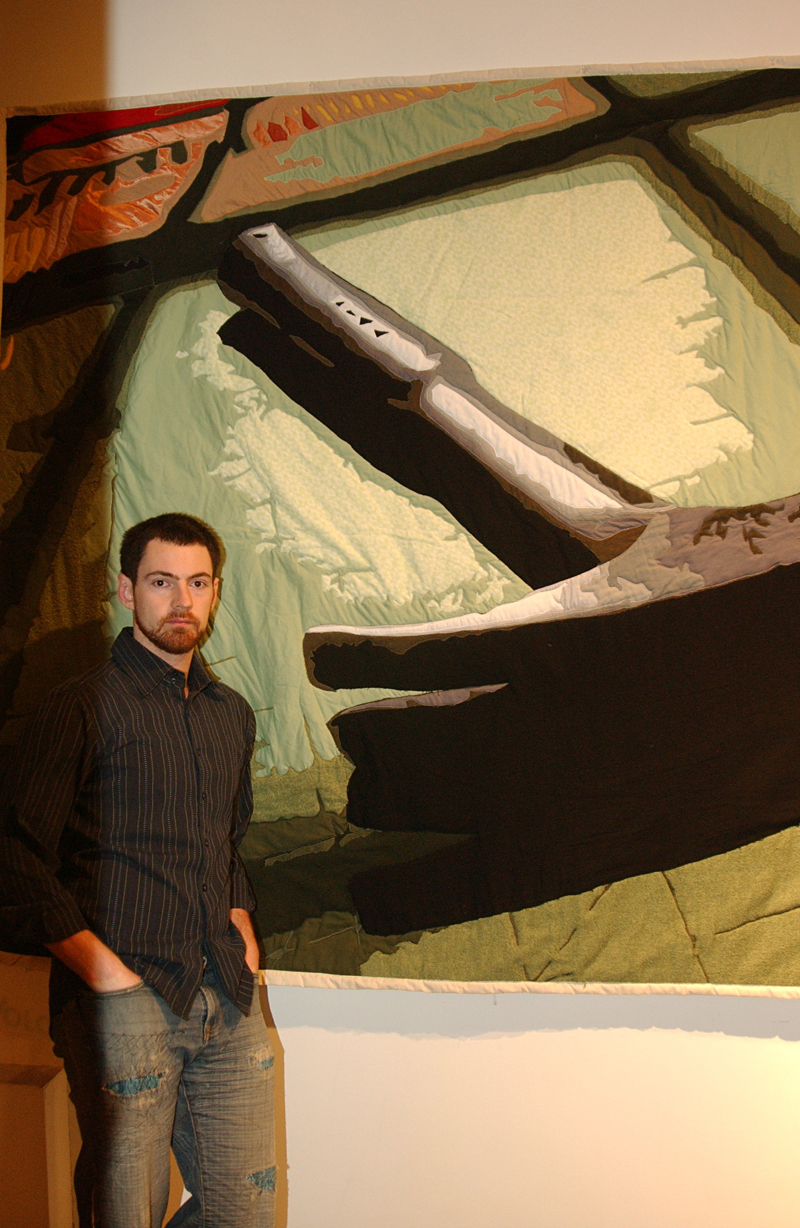When Howard House closed last summer, the gallery seemed destined to remain dark for months, a forlorn reminder of Pioneer Square’s problems for all who passed it during subsequent First Thursday art walks. Then a funny thing happened. In September, a new guy with a giant quilting machine took residence. His face and image were prominently featured on many of the large, colorful quilts hanging from the walls. He put his name on the door, invited other quilt artists to show their work, and even brought a San Francisco dance troupe to perform.
Now, at the end of the month, he’s leaving.
“I’ve done exactly what I wanted to do—people know my name,” says Luke Haynes, a soft-spoken, bearded fellow with the slightest Southern accent.
Haynes isn’t your typical Seattle artist, passively lugging around a portfolio and looking for a gallery to represent him. He had recently moved from the Bay Area to Seattle when he heard of Storefronts Seattle. Devised by the city’s Office of Arts & Cultural Affairs, with an assist from arts funder/administrator Shunpike, to enliven empty retail spaces and shop windows, the program offered 19 artists—selected from hundreds of applicants—just that opportunity in the ID and Pioneer Square: vacant space for free.
“I learned about the space about a week before I moved in,” says Haynes, though the city’s application process likely took a little longer than that. (A second round of artists will be announced March 15.) Haynes had as a goal “to break into the Seattle art market in my own terms,” he explains. “Other artists don’t have the greatest self-promotion. That’s not necessarily something I have a problem with.”
This is evident from some of his photo-based self-portraits staring down from the walls. These bold, Pop-influenced images of the artist are a little bit craftwork, a little bit Warhol. Thanks to his quilting machine, which can produce works up to 25 by 17 feet in size, the rustic old idiom of quilting becomes something monumental (though Haynes makes bedspreads, too).
These quilts aren’t all about him, Haynes explains. In an embroidered series of old coffee bags, on view at Seattle Coffee Works (107 Pike St.) through mid-March, he plays with Seattle iconography, including the Smith Tower, the Space Needle, and the Elephant Car Wash sign. The utilitarian, previously used bags are part of the preservationist appeal of quilting, he says. “It’s all made from recycled material, most usually coming from the used-clothing bins at Goodwill.”
Pointing to a huge, Jasper Johns–ish American flag on the wall, Haynes explains that it’s made of cut-up scraps from an even larger flag; there’s been a reduction and distillation of the iconic colors and pattern. On another wall, a quilt series depicts various hand tools Haynes has used. “This particular hammer is from when I made houses,” he notes.
At the beginning of his residency, Haynes hadn’t ever visited Howard House. As he nears the end, he says he’s gained an appreciation for the gallerist’s craft. “I haven’t made a great deal of work in this space, because my work time was devoted to gallery time,” he says. “I’m not great at sending out press releases.”
Does he consider the venture successful? “Name exposure, brand exposure—yes. Sales and commissions, no. Making art is a whole different skill set than selling myself as a brand.”
The first round of Storefronts Seattle included 11 window installations (in two three-month terms) and eight larger spaces devoted to “creative enterprise and residency,” per the city. Of those, only Haynes stepped up to a gallery model for six full months, where the work demands were steepest.
The next round begins in March and lasts through next January, explains Shunpike’s Ellen Whitlock Baker. “A number of places that we had in the last round were leased,” she notes. The overall number of venues won’t be known for a few weeks. During that time, “We’re wading through all the applications.”
In the meantime, Haynes will be part of a group show called Will You Be My Friend?, opening Feb. 25 at pun(c)tuation (705A E. Pike St.). After he leaves Pioneer Square, he hopes to get back to serious quilt-making at a Greenwood studio—but only until August, when he departs Seattle for a residency in the middle of New York Harbor. There, on Governors Island, he’ll continue his “American Context” series in the shadow of the Statue of Liberty.
Lastly, what advice would he offer to artists new to the Storefronts Seattle program? “Press, press, press. Get the word out two months beforehand.”








